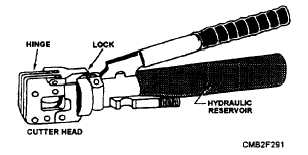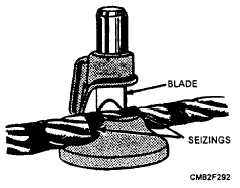Grasp the ends with end-cutting nippers and twist up slack, as shown in step 3. Do not try to tighten the seizing by twisting. Draw up on the seizing, as shown in step 4. Again twist up the slack, using the nippers as shown in step 5. Repeat steps 4 and 5 as needed. Cut the ends and pound them down on the rope, as shown in step 6. If the seizing is to be permanent, use a serving bar, or iron, to increase tension on the seizing wire when putting on the turns.
Wire rope can be cut successfully by a number of methods. An effective and simple method is to use a hydraulic type of wire rope cutter, as shown in figure 6-50. Remember that all wire should be seized before it is cut. For best results in using this method, place the rope in the cutter so the blade comes between the two central seizing. With the release valve closed, jack the blade against the rope at the location of the cut and continue to operate the cutter until the wire rope is cut.
When a hydraulic type of wire cutter is NOT available, other methods can be used. such as a hammer-type wire rope cutter (fig. 6-51), a cutting torch, and, if need be, a hacksaw and cold chisel.
Wire Rope Maintenance
Wire rope bending around hoist drums and sheaves will wear like any other metal article, so lubrication is just as important to an operating wire rope as it is to any other piece of working machinery.

Figure 6-50. - Hydraulic type of wire cutter.

Figure 6-51. - Hammer-type wire rope cutter.
For wire rope to work right, its wires and strands must be free to move. Friction from corrosion or lack of lubrication shortens the service life of wire rope.
Deterioration from corrosion is more dangerous than that from wear because corrosion ruins the inside wires - a process hard to detect by inspection. Deterioration caused by wear can be detected by examining the outside wires of the rope, because these wires become flattened and reduced in diameter, as the wire rope wears.
NOTE
Replace wire rope that has one third of the original diameter of the outside individual wires.
Both internal and external lubrication protects a wire rope against wear and corrosion. Internal lubrication can be properly applied only when the wire rope is being manufactured, and manufacturers customarily coat every wire with a rust-inhibiting lubricant, as it is laid into the strand. The core is also lubricated in manufacturing.
Lubrication that is applied in the field is designed not only to maintain surface lubrication but also to prevent loss of internal lubrication provided by the manufacturer. The Navy issues an asphaltic petroleum oil that must be heated before using. This lubricant is known as Lubricating Oil for Chain, Wire Rope, and Exposed Gear and comes in two types:
Type I, Regular: Does not prevent rust and is used where rust prevention is not needed; for example, elevator wires used inside are not exposed to the weather but need lubrication.
Type II, Protective: A lubricant and an anticorrosive - it comes in three grades: grade A, for cold weather (60F and below); grade B, for warm weather (between 60F and 80F); and grade C, for hot weather (80F and above).
The oil, issued in 25-pound and 35-pound buckets and in 100-pound drums, can be applied with a stiff brush, or the wire rope can be drawn through a trough of hot lubricant (fig. 6-52). The frequency of application depends upon service conditions; as soon as the last coating has appreciably deteriorated, it should be renewed. A good lubricant to use when working in the field, as recommended by COMSECOND/COMTHRIDNCBINST 11200.11, is a mixture of new motor oil and diesel fuel at a ratio of 70-percent oil and 30-percent diesel fuel.
Continue Reading